OpenMusicContest: submit your entry by July 15th!
The doors are now open for submissions to the fourth OpenMusicContest (OMC), one of the largest live concerts for CC-licensed music. Participants may submit tracks of any musical genre by July 15, 2008. Stylistic diversity is desired, and all entries must be licensed under one of the six Creative Commons licenses.
The organizers of the event, the AStA student organization from Philipps University in Marburg, explain that the OMC offers an attractive prize for its participants: artists score a large performance alongside a noteworthy headliner plus space on a sampler featuring the best tracks of the contest. A gratis promotional CD will also be published in the magazine LinuxUser.
The OMC concert will take place in Marburg, Germany on October 17, 2008.
Taxonomy upgrade extras:
Improve AdSense Performance: Step-by-Step Video Guide From The AdSense Team
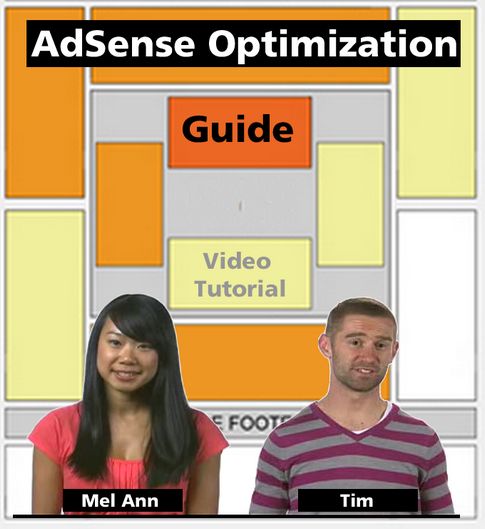 The video provides some very basic concepts and suggest simple strategic approaches to general AdSense optimization that, as far as I can tell, are all right on the mark. These are again, all basic concepts of AdSense optimization and they are definitely targeted at those exposing themselves for the first time to this type of work.
What you should expect to find in it, are fundamental references for optimising AdSense performance - from analysing your page type, to choosing the right ad sizes and colors, and to how you should best monitor and track your results.
Also included, some general advice and tips on how to increase eCPM, without adversely affecting your community's experience on your web site pages.
This introductory video guide covers the following topics:
1. Analysing your webpage
2. Creating custom channels
3. Determining best ad design and placement
4. Maximizing ad units on a page
5. Tracking and measuring your results
Here the video and full text transcript:
The video provides some very basic concepts and suggest simple strategic approaches to general AdSense optimization that, as far as I can tell, are all right on the mark. These are again, all basic concepts of AdSense optimization and they are definitely targeted at those exposing themselves for the first time to this type of work.
What you should expect to find in it, are fundamental references for optimising AdSense performance - from analysing your page type, to choosing the right ad sizes and colors, and to how you should best monitor and track your results.
Also included, some general advice and tips on how to increase eCPM, without adversely affecting your community's experience on your web site pages.
This introductory video guide covers the following topics:
1. Analysing your webpage
2. Creating custom channels
3. Determining best ad design and placement
4. Maximizing ad units on a page
5. Tracking and measuring your results
Here the video and full text transcript:
Google AdSense Steps to Success
The Australian Google AdSense Team introduces the basic of AdSense video optimizationFull English Text Transcription Welcome to a step-by-step guide to making the most out of AdSense. My name is Mel Ann and I am an account manager on the AdSense team in Sidney Australia. Together with my colleague Tim we'll be running through a guide to successful AdSense optimization. One of the great things that Mel Ann and I we love about our job , is helping publishers maximize their Adsense performance via the optimization program. The two aims of the program are: 1) Increase your AdSense revenue and 2) Improve your community's experience on your web site. The optimization guide that follows is all about these two goals.
The Five Steps To Optimizing AdSense On Your Web Pages
Mel Ann: Let's go through the steps for optimizing your web pages. These five steps will take you through a complete optimization. And they are a good starting point for you to improve your AdSense performance. As optimization specialists,Tim and I go through these steps when looking at all our publishers accounts.- Firstly we analyze the content of a web page and determine how your users view the content.
- By using custom channels we also find out which ad units are performing or underperforming, by looking at the channel data available.
- Then we determine the optimum ad formats and placements of your ads such as color, position and size.
- We also make sure that you are getting the most out of having multiple ad units on a page.
- And by checking and measuring the results from when you implement it you will be able to say whether your optimization have made a difference to your AdSense performance.
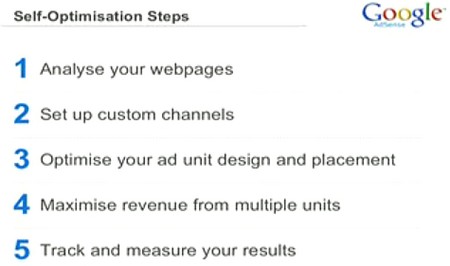
1) Analyze Your Web Pages
 People read pages in different ways and their interaction with ads will depend on a few factors.
Ask yourself these questions:
a) What type of content do you have on your pages?
Some will interact with an article page differently than from a forum. And differently again with a video site.
b) Where is their attention likely to be focused?
If you have your most interesting content at the top of the page the best ad placement will be next to that content. You should place ads where your users are most likely to look and not hide them away at the corner of your page.
c) Ask yourself how you can integrate ads into this area without getting into your users way.
You want to protect your community experience with your web page and not clutter it with ads.
People read pages in different ways and their interaction with ads will depend on a few factors.
Ask yourself these questions:
a) What type of content do you have on your pages?
Some will interact with an article page differently than from a forum. And differently again with a video site.
b) Where is their attention likely to be focused?
If you have your most interesting content at the top of the page the best ad placement will be next to that content. You should place ads where your users are most likely to look and not hide them away at the corner of your page.
c) Ask yourself how you can integrate ads into this area without getting into your users way.
You want to protect your community experience with your web page and not clutter it with ads.
The AdSense Heatmap
This heatmap highlights the areas on a web page where ads perform well. Ads are ideally placed above the fold and close to your primary content. You should place ads where your users are most likely to look and not hide them away. At the end of the day, your knowledge about how your community interacts with your page will guide you on how to best apply these optimization techniques. When analyzing your pages it's also important to think about how advertisers will like to appear on your site. A great way to potentially increase your earnings is by making your site more appealing to advertisers. Earnings, or effective CPM (eCPM) can be increased by advertisers targeting your site in a placement targeting campaign. In a placement targeting campaign an advertiser bids more than all the ads in an ad unit to take up that entire unit with their ad. This is most often an image ad. But it could be video, Flash, or a text ad.
Is Your Site Advertiser Friendly?
The top three ways to ensure that your site is advertiser friendly are: 1) To opt-in to showing text as well as image ads 2) To have well designed and presented content 3) To use large ad units such as the 300x250 medium rectangle.
2) Set Up Custom Channels
 Custom channels allow you to categorize or group different ad units across your site for reporting purposes. They give you a better insight into how individual ad units are performing, and so that you can make decisions about placement, color and style and maximize your user engagement with the ads.
You can manage your custom channels in the "Channels" section, under the AdSense Setup tab.
So after analyzing your pages and determining the way you would like to place your ads make sure you also create a channel for individual ad unit placements. You will be able to compare performance between ad units.
For example by creating a custom channel to track all fo your leaderboard ad units as well as your medium rectangle ad units you will be able to say which ad sizes perform better, in terms of clickthrough rate or revenue.
Tracking individual ad unit metrics ensures that you have the best information possible for maximiming your AdSense performance.
Custom channels allow you to categorize or group different ad units across your site for reporting purposes. They give you a better insight into how individual ad units are performing, and so that you can make decisions about placement, color and style and maximize your user engagement with the ads.
You can manage your custom channels in the "Channels" section, under the AdSense Setup tab.
So after analyzing your pages and determining the way you would like to place your ads make sure you also create a channel for individual ad unit placements. You will be able to compare performance between ad units.
For example by creating a custom channel to track all fo your leaderboard ad units as well as your medium rectangle ad units you will be able to say which ad sizes perform better, in terms of clickthrough rate or revenue.
Tracking individual ad unit metrics ensures that you have the best information possible for maximiming your AdSense performance.
3) Optimize Your Ad Units Design and Performance
Advertisers love to use these formats in placement targetig campaigns as they are common industry standards. The three most popular are: a) The medium rectangle (300x250)
b) Wide skyscraper (160x600)

c) Leaderboard (720x90)
Appropriate Use of Colors
Colors play an important part in keeping your ads looking professional and a relevant part of your site. As text ads show approximately 70 to 80% of the time it is essential that they complement your site. There are several ways you can do this: Simple things like blending in the background of the ads with the color of your site and removing borders have proven in the past to have a significant impact upon clickthrough rate. Just be careful of not blending the ads too much so that they look like your site content. You can also try to highlight the links in the URL with shades that complement your site colors. Remember that tricking your audience to click on ads does not work in the long run and Google penalizes publishers whose users are not interacting properly with ads on page.
So let's summarize the key learnings from looking at ad design and placement.
- We have found that doing an analysis of how your users view information and enjoy the content on your site is absolutely essential to how you choose where to place your ads.
- It's important not to hide your Google ads. As users will actually find them useful if they can see them.
- Integrate your ads with your content and place them where they are visible. You will find that your actual clickthrough rate will actually improve.
- Choose colors for your ads so that they are easily distinguishable from content but still look like they belong to your site.
4) Maximize Revenue From Multiple Units
Now we will move on to how to maximize revenue from the existing ad units on a page. Of course the AdSense team is very wary to suggest you to plaster your pages with ads, so to maximize the yeld from multiple units, we recommend finding ut which unit is performing best on your page. You can do this by setting up custom channels to determine which ad format is outperfoming the rest in terms of having the highest clickthrough rate and eCPM. The first ad unit on a page always shows the highest paying ads. The ones that won the ad auction. These ads pay you the most per click. The first unit on the page is defined as the first instance of HTML code on your page. Place that ad unit first in your HTML so that it will receive the highest paying ads. This will maximize the yield that you can receive from multiple ad units on a page. So for example if you have a leaderboard at the top of your page but a mdeium rectangle that is placed half-way down outperfoms it, then the higher paying ads are better being placed in that medium rectangle where your users click more. If you are comfortable with HTML and JavaScript you probably can figure out a way to place the medium rectangle first in your HTML. However a good result can also be gained by removing the leaderboard from the top and placing it somewhere else on a page so that the medium rectangle appears first in your pages source code.5) Track and Measure Your Results
 Let's go over the best ways of tracking and measuring your optimization results. As I have mentioned previously, using AdSense channels is a great way to track AdSense performance at the individual ad unit level. This next section will detail how to use methods best.
I am sure everyone is familiar with the "Reports" tab in your AdSense account. To generate a report on your custom channels click on the Advanced Reports subtab. Select the "channel data" radio button and the channels that you would like to compare.
You also have the option of showing your results by date, channel, or both. Below you'll see your results.
In this example (see video) we have grouped results by date. This gives results for each day for all the custom channels you have selected.
Even more useful is grouping your results by channels. This allows you to compare different ad units based on placement, color or format. Success in using this feature depends on whether you have set up custom channels to track these ads in the first place.
In this example we are comparing the performance of your 160x600 skyscraper against the 300x250 medium rectangle. If we were to run these reports over a monthly time frame and see that the 300x250 medium rectangle is performing better, we may try first ad unit optimization, as discussed by Tim.
Generating "placement targeting reports" is done within the same panel. Simply select the "Show Data by" option and change it to individual ad units. This allows you to see which ad units are receiving placement targeted ads and whether your optimization has effectively improved your eCPM.
Let's go over the best ways of tracking and measuring your optimization results. As I have mentioned previously, using AdSense channels is a great way to track AdSense performance at the individual ad unit level. This next section will detail how to use methods best.
I am sure everyone is familiar with the "Reports" tab in your AdSense account. To generate a report on your custom channels click on the Advanced Reports subtab. Select the "channel data" radio button and the channels that you would like to compare.
You also have the option of showing your results by date, channel, or both. Below you'll see your results.
In this example (see video) we have grouped results by date. This gives results for each day for all the custom channels you have selected.
Even more useful is grouping your results by channels. This allows you to compare different ad units based on placement, color or format. Success in using this feature depends on whether you have set up custom channels to track these ads in the first place.
In this example we are comparing the performance of your 160x600 skyscraper against the 300x250 medium rectangle. If we were to run these reports over a monthly time frame and see that the 300x250 medium rectangle is performing better, we may try first ad unit optimization, as discussed by Tim.
Generating "placement targeting reports" is done within the same panel. Simply select the "Show Data by" option and change it to individual ad units. This allows you to see which ad units are receiving placement targeted ads and whether your optimization has effectively improved your eCPM.
Resources for AdSense Optimization
 Let's look through some of the great resources available for AdSense optimization.
In the AdSense Help Center you'll find the answers to our most common questions as well as more techniques to help you improve your AdSense performance. Try searching for "optimizing AdSense" in the Help Center and walk through the easy to implement solutions for getting the most out of AdSense.
Google AdSense Help Forum is a place for you to learn and share the optimization techniques with other AdSense publishers. You can browser previous threads and comments or post a new conversation on how to approach your Adsense optimization on your site.
If you have any questions about AdSense or if you would like more detail on AdSense optimization in general please feel free to contact the AdSense team by emailing adsense-support@google.com or go to the Help Center guide
Let's look through some of the great resources available for AdSense optimization.
In the AdSense Help Center you'll find the answers to our most common questions as well as more techniques to help you improve your AdSense performance. Try searching for "optimizing AdSense" in the Help Center and walk through the easy to implement solutions for getting the most out of AdSense.
Google AdSense Help Forum is a place for you to learn and share the optimization techniques with other AdSense publishers. You can browser previous threads and comments or post a new conversation on how to approach your Adsense optimization on your site.
If you have any questions about AdSense or if you would like more detail on AdSense optimization in general please feel free to contact the AdSense team by emailing adsense-support@google.com or go to the Help Center guide
Video by the Australian Google AdSense Team - "Five steps to optimising your AdSense performance" - YouTube link - Formatting, illustrations and full English text transcription by Robin Good.
Taxonomy upgrade extras:
Virtual property at the mercy of operators
Submitted by dillon coil last modified Wed, 06/25/2008 - 3:02pm
As the struggle continues to protect intellectual property in our rapidly evolving technological landscape, a new kind of property is emerging that might prove even more vexing, virtual property.
Virtual property is created, exchanged, and sold everyday in virtual worlds such as Linden’s Second Life or Habbo Hotel , as well as in MMORPGs (massively multiplayer online role playing games) like Blizzard’s World of Warcraft . A quick text search for Second Life on eBay.com reveals hundreds of listings to bid on ‘Linden Dollars’ with which Second Life members may purchase real estate, clothing, or scripts for just about anything within the Second Life world. Initially this may not have appeared to be problem. Today however, some participants are earning serious money from their virtual property and are investing significant real world resources to do so. What was once an isolated group of hobbyists is becoming big business, and the legal issues naturally follow.
The most prominent success story in the virtual economy is that of virtual real estate magnate and Second Life fashion designer Anshe Chung , a fictional avatar in the Second Life world. In late 2006, Anshe hit real world headlines when she announced her real-world net worth of over one million dollars earned entirely though her Second Life activities. Anshe has since been featured (in avatar form) on the cover of Business Week , and has also been interviewed in Forbes Magazine. She employs over 60 people full-time to manage her empire which sells and rents virtual real estate, clothing, and most recently, provides virtual banking services in other virtual worlds.
While not everyone is making a fortune, Second Life claims that in May of this year 189 individual users of Second Life earned more than $5,000 from their online exploits. These numbers are just scratching the surface of what is to come. In countries like South Korea, ninety percent of those who are between the ages of twenty and thirty are members of a virtual world called Cyworld , which happens to sell over $300,000 worth of the currency called ‘acorns’ to their users everyday.
With all of this time and money being invested in virtual property, it wasn’t long before the issue popped up in court. The first big case was Bragg v. Linden Research . Bragg, an independent lawyer and Second Life enthusiast, found a way to manipulate the urls associated with purchasing land plots from Second Life in order to purchase plots still unavailable for public sale, and at much lower rates. Linden discovered the activity and canceled Bragg’s account , erasing the structures he built on his land. Bragg filed suit against Linden claiming they deprived him of over $8,000 in virtual property, including property he had purchased before his unauthorized activity. Unfortunately, the case settled privately before the court could rule on the issue, but we do know that Linden reinstated his account and replaced Bragg’s property to some extent. Linden has since modified their user agreement to strengthen their ability to act in future disputes.
Linden’s move to leverage their position is indicative of the constant struggle between virtual world operators’ rights and users’ rights, especially users’ rights in their virtual property. It’s this very relationship that has led some to label Linden’s founder Philip Rosedale as a dictator . While agreeing that he may be a dictator in the generic sense, Rosedale argues that Linden never takes land without reason, unlike real world dictatorships. Rosedale insists that it’s in Linden’s own interest to respect users’ rights because to do otherwise “would so risk everything we have built .” But one fact remains; as long as operators such as Rosedale can terminate accounts largely on their own terms, users will be investing in virtual property at their own risk.
Create An Online Interactive Multimedia Magazine From Any Document With Calameo
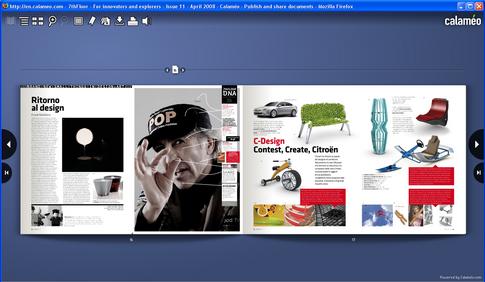 Photo credit: Ophelia Cherry
So, whether you have a PDF file a .doc report or an OpenOffice presentation you can easily create high-impact interactive visual magazines that can be distributed via email, social news sites and via an embeddable snippet of code allowing any Calameo based magazine to be republished on any web site or blog.
Here more details:
Photo credit: Ophelia Cherry
So, whether you have a PDF file a .doc report or an OpenOffice presentation you can easily create high-impact interactive visual magazines that can be distributed via email, social news sites and via an embeddable snippet of code allowing any Calameo based magazine to be republished on any web site or blog.
Here more details:
Overview
 Calaméo is a web-based service which creates glossy, highly visual versions of most any document you submit in order to provide a richer and more comfortable reading experience.
Online publications created with Calameo can be downloaded, shared / embedded on other sites, and sent as a link to be viewed to any number of recipients and independently of the operating system, or browser type being used.
In other words, Calameo is a tool capable of producing slick-looking interactive documents with little effort and no tech know-how required on the part of the publisher. These interactive documents are particularly interesting as they offer multiple navigation and browsing options, a good search functionality, easy zooming and scrolling through the document and a simple and intuitive user interface.
Personalization also plays an important roleinside Calameo, allowing you, the publisher, to easily characterize your publication through a wide choice of personalization options (background image, music, interactive links, etc.).
Calameo-generated documents can be published and shared publicly or can be kept under secure access for your restricted team of colleagues. Calaméo allows you to share your publications with the people of your choice, in complete safety.
Calameo also allows you to organize multiple types of documents you want to publish into separate "subscriptions" allowing the actual creation of different publication channels.
Social features are well integrated into this online publishing tool allowing for readers to comment and start discussions on any document you have configured for open social interaction.
Calaméo is a web-based service which creates glossy, highly visual versions of most any document you submit in order to provide a richer and more comfortable reading experience.
Online publications created with Calameo can be downloaded, shared / embedded on other sites, and sent as a link to be viewed to any number of recipients and independently of the operating system, or browser type being used.
In other words, Calameo is a tool capable of producing slick-looking interactive documents with little effort and no tech know-how required on the part of the publisher. These interactive documents are particularly interesting as they offer multiple navigation and browsing options, a good search functionality, easy zooming and scrolling through the document and a simple and intuitive user interface.
Personalization also plays an important roleinside Calameo, allowing you, the publisher, to easily characterize your publication through a wide choice of personalization options (background image, music, interactive links, etc.).
Calameo-generated documents can be published and shared publicly or can be kept under secure access for your restricted team of colleagues. Calaméo allows you to share your publications with the people of your choice, in complete safety.
Calameo also allows you to organize multiple types of documents you want to publish into separate "subscriptions" allowing the actual creation of different publication channels.
Social features are well integrated into this online publishing tool allowing for readers to comment and start discussions on any document you have configured for open social interaction.
Key Features
Document Conversion - Files Type Supported
Calameo can easily convert most type of documents and files with no additional help. Files can be as large as 100MB each, and here are the specific document formats supported.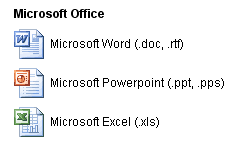
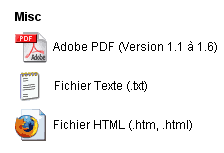
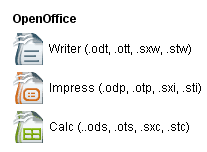
Player Features - Navigation Controls
Once a document has been converted into Calameo, it is displayed within a custom Flash player. To navigate the newly created document a navigation toolbar is available on the top left area of the Calameo player. Key navigation options from left to right include:
a) Publication
Switch back to main publication mode from any other of the available viewing modes.
b) Subscriptions
Allow readers to discover and access your other content channels, magazines or publications.
c) Thumbnail view of all pages
View the whole publication as a series of thumbnails.
d) Full screen view
Launch the viewer in full screen mode.
e) Bookmarking
Bookmark specific pages or sections for later review.
f) Zoom-In Zoom-Out
Easily zoom in and out of the document for maximum readability.
g) Audio volume
Control or mute audio volume for multimedia publications which contain audio as well.
Key navigation options from left to right include:
a) Publication
Switch back to main publication mode from any other of the available viewing modes.
b) Subscriptions
Allow readers to discover and access your other content channels, magazines or publications.
c) Thumbnail view of all pages
View the whole publication as a series of thumbnails.
d) Full screen view
Launch the viewer in full screen mode.
e) Bookmarking
Bookmark specific pages or sections for later review.
f) Zoom-In Zoom-Out
Easily zoom in and out of the document for maximum readability.
g) Audio volume
Control or mute audio volume for multimedia publications which contain audio as well.
Delivery and Distribution
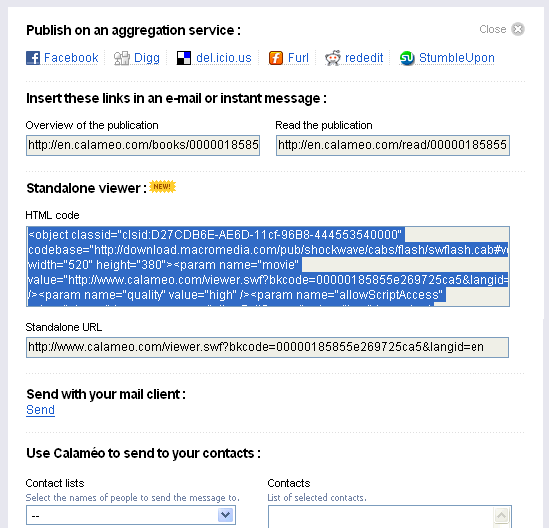 With Calameo all of your documents can be easily shared either as fully viewable embedded documents, or via a small mini-Calameo player. At the moment of publication you can also immediately invite selected contacts as well as post your doc to some of the most popular social news sites.
Publications created with Calameo can be easily distributed, shared, republished, subscribed to in multiple ways. Converted documents can in fact be set for open download by readers, as well as for open republication via the Calameo mini-embeddable player you see above this paragraph.
An RSS feed is also available. Social news and bookmarking facilities also allow anyone to easily repost any Calameo publication to some of the most popular social news sites such Facebook, Digg or Reddit.
With Calameo all of your documents can be easily shared either as fully viewable embedded documents, or via a small mini-Calameo player. At the moment of publication you can also immediately invite selected contacts as well as post your doc to some of the most popular social news sites.
Publications created with Calameo can be easily distributed, shared, republished, subscribed to in multiple ways. Converted documents can in fact be set for open download by readers, as well as for open republication via the Calameo mini-embeddable player you see above this paragraph.
An RSS feed is also available. Social news and bookmarking facilities also allow anyone to easily repost any Calameo publication to some of the most popular social news sites such Facebook, Digg or Reddit.

Community Features
Calameo sports the standard set of social and community features allowing you to invite as many people as you want to watch, comment and discuss around your publications directly from within the Calameo interface.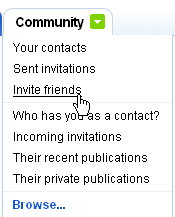
Search
The Calameo search facility module doesn't get a prize for its UI, but it does deliver solid results, that are visually navigable and immediately accessible. It appears to be also very fast.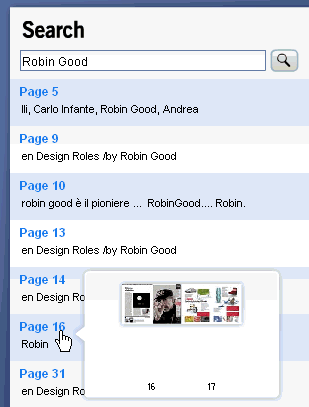
Customization
Calameo offers a nice set of interesting customization features for your own publications. These range from integrating your own image or logo in the player, to the addition of background music and more.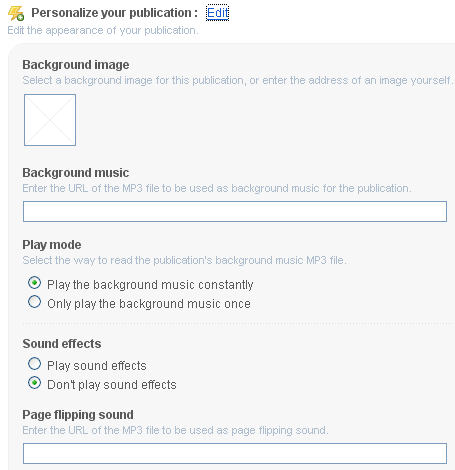
Multimedia Editing
One of the coolest features of Calameo allows you to edit your uploaded document and add to it links to other web sites, links to specific pages inside the document, MP3 sounds, video clips in FLV format and animation s in SWF file format.


Licensing
All documents published with Calameo must be files for which you do have full publishing and distribution rights. You cannot just take any electronic version of a magazine and re-publish it through this service. If you do, you may run into some serious penal issues. If you are the originator of your own documents to be published via Calameo you have also the nice option of being able to select the type of Creative Commons licence that you want to use for each publication.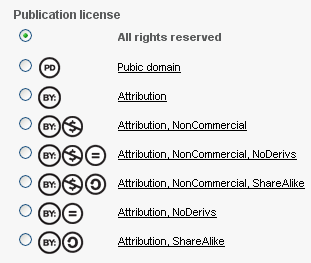
Other Cool Features
A number of other valuable features is available when you create a new publication and includes options to share the document and to make it easy for others to access it.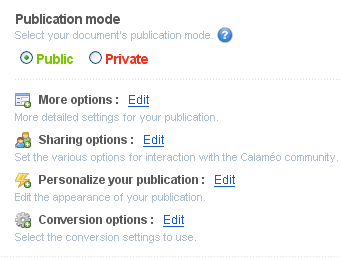 Advanced conversion options allow you to set whether original fonts should be integrated in the final converted publication doc (this will make it larger in size and therefore slower to load) or if Calameo will try to approximate itself the closest available font to the layout specs. Quality of compressed images can also be converted from these conversion options.
Advanced conversion options allow you to set whether original fonts should be integrated in the final converted publication doc (this will make it larger in size and therefore slower to load) or if Calameo will try to approximate itself the closest available font to the layout specs. Quality of compressed images can also be converted from these conversion options.
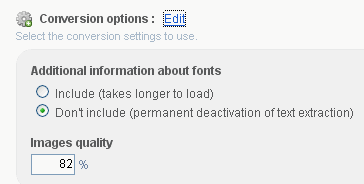
Plans & Pricing
The basic service, which is fully free, has lots to offer without asking anything in return. The PRO version, which costs €149/year (apx. $190 ) provides you with greater ability to customize your publication, tools to manage directly your mailing list, traffic and viewing stats, no ads.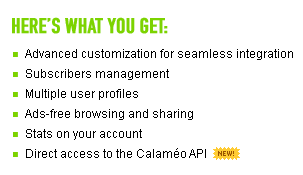 The PRO version has also added access to the Calameo API, allowing your programmers to tap right into the Calameo engine and data output elements.
The PRO version has also added access to the Calameo API, allowing your programmers to tap right into the Calameo engine and data output elements.
In Summary
Pros - Key Strengths
Support for a wide variety of popular file formats Web-based - works with all browsers and operating systems Free - all of the basic core functionalities are available for free Slick, interactive document player Cool navigation and browsing tools Customization options Editable - links, videos and animations can be added to your original document Embeddable on other sites Downloadable - original document can be made available for download if desired Privacy - any document can be set to be published as fully "public" or as "private" Community features Social news sites support RSS supportCons - To Improve
Help and documentation - very sparse and thin - badly organized - difficult to navigate AdSense ads - AdSense ads are present on almost every public page of this service site. While I understand the basic needs for bringing in any possible extra revenue during these early phases I find the presence of ads distracting and discrediting for the site prestige and credibility. They should not be there. The "action" buttons used to edit or save information inside Calameo all use strange and non-standard terms for functions. Distracting and confusing. Somewhat confusing navigation inside Calameo web-based account. Not intuitive path to find mini-player and sharing functionalities.Editor's Comments
Here is an innovative online publishing tool which raises the bar for quality of results (final page layouts) as well as for speed and ease of use. Targeted at those wanting to distribute their contents online in a more prestigious, slick and interactive format, Europe-based Calameo has created a useful service, which similarly to Scribd or Docstoc allows you to easily publish and distribute any document online. Calameo key strengths are the wide support for a variety of popular document formats, a cool and highly usable distribution interface, alongside some nifty customization features, RSS support, publication embedding, as well as full downloading (if allowed) of original documents. Although still in beta, Calameo looks like a promising service for online publishers, especially for those who want to extract higher value from the distribution medium Calameo puts at their disposal. From the viewpoint of professional online publishers, the opportunity is in creating premium options that serve directly the needs of those wanting to use this platform as a way to market and sell their know-how, services or physical products. In this light, potential integration of ecommerce payments, squeeze page features, list building and similar marketing tools could further characterize Calameo from its competitors, while addressing aggressively one of the most rapidly moving segments on the net. I believe that there is ample market opportunities for online publishing tools like this one, as long as they are courageous and shrewd enough to address very specific needs and applications. Doing something cool that tries to satisfy many different needs and audience types is generally bound to have much harder chances of survival.Learn More
About Calameo Calameo Help (very cumbersome to navigate and rather sparse in contents) Press Release - April 21st 2008Originally written by Robin Good for Master New Media and first published on Tuesday June 24th 2008 as "Create An Online Interactive Magazine From Any Document With Calameo"
Taxonomy upgrade extras:
Create An Online Interactive Multimedia Magazine From Any Document With Calameo
 So, whether you have a PDF file a .doc report or an OpenOffice presentation you can easily create high-impact interactive visual magazines that can be distributed via email, social news sites and via an embeddable snippet of code allowing any Calameo based magazine to be republished on any web site or blog.
Here more details:
So, whether you have a PDF file a .doc report or an OpenOffice presentation you can easily create high-impact interactive visual magazines that can be distributed via email, social news sites and via an embeddable snippet of code allowing any Calameo based magazine to be republished on any web site or blog.
Here more details:
Overview
 Calaméo is a web-based service which creates glossy, highly visual versions of most any document you submit in order to provide a richer and more comfortable reading experience.
Online publications created with Calameo can be downloaded, shared / embedded on other sites, and sent as a link to be viewed to any number of recipients and independently of the operating system, or browser type being used.
In other words, Calameo is a tool capable of producing slick-looking interactive documents with little effort and no tech know-how required on the part of the publisher. These interactive documents are particularly interesting as they offer multiple navigation and browsing options, a good search functionality, easy zooming and scrolling through the document and a simple and intuitive user interface.
Personalization also plays an important roleinside Calameo, allowing you, the publisher, to easily characterize your publication through a wide choice of personalization options (background image, music, interactive links, etc.).
Calameo-generated documents can be published and shared publicly or can be kept under secure access for your restricted team of colleagues. Calaméo allows you to share your publications with the people of your choice, in complete safety.
Calameo also allows you to organize multiple types of documents you want to publish into separate "subscriptions" allowing the actual creation of different publication channels.
Social features are well integrated into this online publishing tool allowing for readers to comment and start discussions on any document you have configured for open social interaction.
Calaméo is a web-based service which creates glossy, highly visual versions of most any document you submit in order to provide a richer and more comfortable reading experience.
Online publications created with Calameo can be downloaded, shared / embedded on other sites, and sent as a link to be viewed to any number of recipients and independently of the operating system, or browser type being used.
In other words, Calameo is a tool capable of producing slick-looking interactive documents with little effort and no tech know-how required on the part of the publisher. These interactive documents are particularly interesting as they offer multiple navigation and browsing options, a good search functionality, easy zooming and scrolling through the document and a simple and intuitive user interface.
Personalization also plays an important roleinside Calameo, allowing you, the publisher, to easily characterize your publication through a wide choice of personalization options (background image, music, interactive links, etc.).
Calameo-generated documents can be published and shared publicly or can be kept under secure access for your restricted team of colleagues. Calaméo allows you to share your publications with the people of your choice, in complete safety.
Calameo also allows you to organize multiple types of documents you want to publish into separate "subscriptions" allowing the actual creation of different publication channels.
Social features are well integrated into this online publishing tool allowing for readers to comment and start discussions on any document you have configured for open social interaction.
Key Features
Document Conversion - Files Type Supported
Calameo can easily convert most type of documents and files with no additional help. Files can be as large as 100MB each, and here are the specific document formats supported.


Player Features - Navigation Controls
Once a document has been converted into Calameo, it is displayed within a custom Flash player. To navigate the newly created document a navigation toolbar is available on the top left area of the Calameo player. Key navigation options from left to right include:
a) Publication
Switch back to main publication mode from any other of the available viewing modes.
b) Subscriptions
Allow readers to discover and access your other content channels, magazines or publications.
c) Thumbnail view of all pages
View the whole publication as a series of thumbnails.
d) Full screen view
Launch the viewer in full screen mode.
e) Bookmarking
Bookmark specific pages or sections for later review.
f) Zoom-In Zoom-Out
Easily zoom in and out of the document for maximum readability.
g) Audio volume
Control or mute audio volume for multimedia publications which contain audio as well.
Key navigation options from left to right include:
a) Publication
Switch back to main publication mode from any other of the available viewing modes.
b) Subscriptions
Allow readers to discover and access your other content channels, magazines or publications.
c) Thumbnail view of all pages
View the whole publication as a series of thumbnails.
d) Full screen view
Launch the viewer in full screen mode.
e) Bookmarking
Bookmark specific pages or sections for later review.
f) Zoom-In Zoom-Out
Easily zoom in and out of the document for maximum readability.
g) Audio volume
Control or mute audio volume for multimedia publications which contain audio as well.
Delivery and Distribution
 With Calameo all of your documents can be easily shared either as fully viewable embedded documents, or via a small mini-Calameo player. At the moment of publication you can also immediately invite selected contacts as well as post your doc to some of the most popular social news sites.
Publications created with Calameo can be easily distributed, shared, republished, subscribed to in multiple ways. Converted documents can in fact be set for open download by readers, as well as for open republication via the Calameo mini-embeddable player you see above this paragraph.
An RSS feed is also available. Social news and bookmarking facilities also allow anyone to easily repost any Calameo publication to some of the most popular social news sites such Facebook, Digg or Reddit.
With Calameo all of your documents can be easily shared either as fully viewable embedded documents, or via a small mini-Calameo player. At the moment of publication you can also immediately invite selected contacts as well as post your doc to some of the most popular social news sites.
Publications created with Calameo can be easily distributed, shared, republished, subscribed to in multiple ways. Converted documents can in fact be set for open download by readers, as well as for open republication via the Calameo mini-embeddable player you see above this paragraph.
An RSS feed is also available. Social news and bookmarking facilities also allow anyone to easily repost any Calameo publication to some of the most popular social news sites such Facebook, Digg or Reddit.

Community Features
Calameo sports the standard set of social and community features allowing you to invite as many people as you want to watch, comment and discuss around your publications directly from within the Calameo interface.
Search
The Calameo search facility module doesn't get a prize for its UI, but it does deliver solid results, that are visually navigable and immediately accessible. It appears to be also very fast.
Customization
Calameo offers a nice set of interesting customization features for your own publications. These range from integrating your own image or logo in the player, to the addition of background music and more.
Multimedia Editing
One of the coolest features of Calameo allows you to edit your uploaded document and add to it links to other web sites, links to specific pages inside the document, MP3 sounds, video clips in FLV format and animation s in SWF file format.


Licensing
All documents published with Calameo must be files for which you do have full publishing and distribution rights. You cannot just take any electronic version of a magazine and re-publish it through this service. If you do, you may run into some serious penal issues. If you are the originator of your own documents to be published via Calameo you have also the nice option of being able to select the type of Creative Commons licence that you want to use for each publication.
Other Cool Features
A number of other valuable features is available when you create a new publication and includes options to share the document and to make it easy for others to access it. Advanced conversion options allow you to set whether original fonts should be integrated in the final converted publication doc (this will make it larger in size and therefore slower to load) or if Calameo will try to approximate itself the closest available font to the layout specs. Quality of compressed images can also be converted from these conversion options.
Advanced conversion options allow you to set whether original fonts should be integrated in the final converted publication doc (this will make it larger in size and therefore slower to load) or if Calameo will try to approximate itself the closest available font to the layout specs. Quality of compressed images can also be converted from these conversion options.

Plans & Pricing
The basic service, which is fully free, has lots to offer without asking anything in return. The PRO version, which costs €149/year (apx. $190 ) provides you with greater ability to customize your publication, tools to manage directly your mailing list, traffic and viewing stats, no ads. The PRO version has also added access to the Calameo API, allowing your programmers to tap right into the Calameo engine and data output elements.
The PRO version has also added access to the Calameo API, allowing your programmers to tap right into the Calameo engine and data output elements.
In Summary
Pros - Key Strengths
Support for a wide variety of popular file formats Web-based - works with all browsers and operating systems Free - all of the basic core functionalities are available for free Slick, interactive document player Cool navigation and browsing tools Customization options Editable - links, videos and animations can be added to your original document Embeddable on other sites Downloadable - original document can be made available for download if desired Privacy - any document can be set to be published as fully "public" or as "private" Community features Social news sites support RSS supportCons - To Improve
Help and documentation - very sparse and thin - badly organized - difficult to navigate AdSense ads - AdSense ads are present on almost every public page of this service site. While I understand the basic needs for bringing in any possible extra revenue during these early phases I find the presence of ads distracting and discrediting for the site prestige and credibility. They should not be there. The "action" buttons used to edit or save information inside Calameo all use strange and non-standard terms for functions. Distracting and confusing. Somewhat confusing navigation inside Calameo web-based account. Not intuitive path to find mini-player and sharing functionalities.Editor's Comments
Here is an innovative online publishing tool which raises the bar for quality of results (final page layouts) as well as for speed and ease of use. Targeted at those wanting to distribute their contents online in a more prestigious, slick and interactive format, Europe-based Calameo has created a useful service, which similarly to Scribd or Docstoc allows you to easily publish and distribute any document online. Calameo key strengths are the wide support for a variety of popular document formats, a cool and highly usable distribution interface, alongside some nifty customization features, RSS support, publication embedding, as well as full downloading (if allowed) of original documents. Although still in beta, Calameo looks like a promising service for online publishers, especially for those who want to extract higher value from the distribution medium Calameo puts at their disposal. From the viewpoint of professional online publishers, the opportunity is in creating premium options that serve directly the needs of those wanting to use this platform as a way to market and sell their know-how, services or physical products. In this light, potential integration of ecommerce payments, squeeze page features, list building and similar marketing tools could further characterize Calameo from its competitors, while addressing aggressively one of the most rapidly moving segments on the net. I believe that there is ample market opportunities for online publishing tools like this one, as long as they are courageous and shrewd enough to address very specific needs and applications. Doing something cool that tries to satisfy many different needs and audience types is generally bound to have much harder chances of survival.Learn More
About Calameo Calameo Help (very cumbersome to navigate and rather sparse in contents) Press Release - April 21st 2008Originally written by Robin Good for Master New Media and first published on Tuesday June 24th 2008 as "Create An Online Interactive Magazine From Any Document With Calameo"
Taxonomy upgrade extras:
Judge Sanctions Lawyer for Issuing Subpoena to Blogger Kathleen Seidel
A federal magistrate judge in New Hampshire has sanctioned Clifford Shoemaker, a Virginia attorney, for abusing the legal process by issuing a subpoena to Kathleen Seidel. Seidel publishes the blog Neurodiversity, where she writes about autism issues. In February 2008, she wrote about a lawsuit against various vaccine manufacturers, Sykes v. Bayer, in which the plaintiffs Lisa and Seth Sykes sought to link exposure to mercury to their son's autism. (For more on her statements about the lawsuit, see my previous post: Blogger Kathleen Seidel Fights Subpoena Seeking Information About Vaccine Litigation.)
On March 24, 2008, Shoemaker, an attorney for the Sykes, served Seidel with a subpoena in connection with the Sykes v. Bayer lawsuit. The subpoena demanded that Seidel appear for a deposition on April 30, 2008, and that she produce a shockingly broad collection of information, including her bank statements, tax returns, communications with religious organizations, and personal correspondence with other bloggers.On April 21, magistrate judge Muirhead granted Seidel's well argued motion to quash the subpoena. The judge also ordered Shoemaker to show cause why he should not be sanctioned under Federal Rule of Civil Procedure 11 for issuing the subpoena. In response, Shoemaker filed a rambling opposition to potential sanctions in which he asserted that Seidel was engaged in a conspiracy with Bayer and others to harass him, his client, and various witnesses. (With the help of Paul Levy from Public Citizen, Seidel filed a restrained response that made Shoemaker's outlandish claims seem all the more, well, outlandish.)
Not surprisingly, the judge didn't buy any of Shoemaker's conspiracy theories and in a strongly worded opinion, made it clear that the subpoena was an abuse of the legal process:
Mr. Shoemaker made no attempt to avoid imposing an undue burden or expense on Ms. Seidel. To the contrary, I find that he sought to burden her by requiring production of every scrap of paper related to autism, her web site, her tax returns, and her communications with the government. He improperly imposes a requirement to create documents, e.g., a list of “names of persons helping, paying or facilitating . . . these endeavors.” The documentation sought is exhaustive. . . .
Shoemaker has not offered a shred of evidence to support his speculations. He has, he says, had his suspicions aroused because she has so much information. Clearly he is unfamiliar with the extent of the information which a highly-competent librarian like Ms. Seidel can, and did, accumulate. If Shoemaker wanted to know if Ms. Seidel was in part supported by or provided information by Bayer, he could have inquired of Bayer or limited the Seidel subpoena to that information. Instead he issued the subpoena calling for production of documents and a deposition on the day before he stipulated to dismiss the underlying suit with prejudice. His failure to withdraw the subpoena when he clearly knew that suit was over is telling about his motives. His efforts to vilify and demean Ms. Seidel are unwarranted and unseemly.
In the end, the judge didn't order Shoemaker to pay a monetary sanction, but he did order the Virginia lawyer to attend ethics training and directed his court clerk to notify the Virginia State Bar so that it could consider disciplinary action on its own.
Shoemaker and his client have a right to disagree with Seidel and, if they think they've been the victims of a conspiracy, to sue her. But they don't have a right to misuse the legal system to coerce a critic to "shut up." As I've noted before, we all lose when we allow that to happen.
(You can read more about the case in our Legal Threats Database entry: Sykes v. Seidel.)
Taxonomy upgrade extras:
Sun: Java will be free this year
Phipps says Java is expected to be completely free within the coming few months. "I'm expecting that certainly by the end of this year and hopefully sooner we'll have all of the source code for Java under the GPL", he said. - ZDNet Asia
Taxonomy upgrade extras:
CC Salon LA (6/26/08): Curt Smith and Monk Turner Discuss CC+Music

CC Salon LA is back NEXT WEEK (6/26/08) with an awesome lineup to get your summer CC brain cells churning at warp speed!
Joining us will be Curt Smith, solo-artist and co-founder of Tears for Fears, who will be discussing the decision to release his most recent album Halfway, Pleased under a CC license. Also presenting will be Monk Turner, an LA-based multi-instrumentalist (and former Featured Commoner) who has been using a combination of CC licences and archive.org to release numerous concept albums that are unique not only in distribution but music style and aesthetic. Both will talk about musicians in general, their personal decision to use CC licences, and how using CC licences can have promotional, ethical, and artistic impact beyond traditional copyright.
The Salon will be taking place at the wonderful FOUND LA Gallery (Google map) from 7:30PM - 9:30PM. Follow the event on Upcoming, mark attending on Facebook, but most importantly don’t miss out on what is bound to be a great conversation on how CC licensees work on a practical level for musicians in particular but content creators in general.
Taxonomy upgrade extras:
Web-Based Mind-Mapping: Outline, Plan and Brainstorm Ideas Together With MindMeister
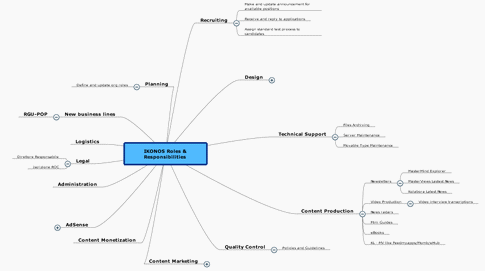 A roles and responsibilities mindmap collaborative mindmap created with MindMeister
Thanks to unforgettable MasterNewMedia editor Antonella Pastore, who first covered mindmaps in 2004 (!), mindmaps have been on my radar for quite some time, but with the recent advent of online, collaboratively editable mindmaps the opportunities to reap significant benefit from these tools has just exploded.
The great thing about collaborative, web-based mind-maps is the ease with which you can visualize spatially while giving very precise text labels to ideas, tasks, projects and to the relationships between them. These two characteristics by themselves when mixed with ability to watch and edit in real-time the same visual map with others creates a truly effective, useful and memorable way of collaborating productively at a distance.
Here more details:
A roles and responsibilities mindmap collaborative mindmap created with MindMeister
Thanks to unforgettable MasterNewMedia editor Antonella Pastore, who first covered mindmaps in 2004 (!), mindmaps have been on my radar for quite some time, but with the recent advent of online, collaboratively editable mindmaps the opportunities to reap significant benefit from these tools has just exploded.
The great thing about collaborative, web-based mind-maps is the ease with which you can visualize spatially while giving very precise text labels to ideas, tasks, projects and to the relationships between them. These two characteristics by themselves when mixed with ability to watch and edit in real-time the same visual map with others creates a truly effective, useful and memorable way of collaborating productively at a distance.
Here more details:
MindMapping Overview
Mind-mapping is all about visualizing ideas through simple star-like diagrams in which there is always one central idea / object. To this central node you can add unlimited branches and sub-branches with maximum freedom relative to size and positioning of each one. This simple setup allows you to easily outline project tasks, resources lists, and even to plan out a sequence of steps to be taken. Learning curve zero. All it takes to learn how to operate a typical mind-mapping tool is learning two keyboard keys: one to create new first level objects and another one to create "nested" ones. That's it. Once you have gotten those two keys down you can basically create mind-maps that can get as complex and rich as your imagination.Mind-Mapping Tools
Out there there are both great, highly usable and simple mind-mapping tools, as well as others, which while more feature-rich, require a bit more of understanding and studying before they can be put to full use. You need not spend any amount of money to get a decent first-time experience with mind-mapping tools. Direction yourself to this new breed of web-based mind-mapping tools and in my humble opinion you'll be on safer side. Yes, there are some very good mindmapping tools like Mindjet MindManager which you can download try fully out for a limited time, but given the steeper learning curve, much richer feature set, and not so friendly support and customer service you may find at this more established venues, I strongly suggest that unless you are already a mindmapping veteran you start from a simple, and immediately easy to use web-based mindmapping tool like one of those listed here below: Mindmomo Wisemapping Bubblus Mindmeister Here is an extensive list of mindmapping tools including non -web-based, desktop software. As you have probably guessed, my favorite among these web-based mindmapping tools is MindMeister, though each one of those others has its unique pros and cons depending on the task at hand. I have discovered MindMeister thanks to someone else who recommended Mindjet MindManager Pro, and suggested as a possible lower level alternative MindMeister. Having tried them both, and having interacted a bit with both companies, I really have no hesitation in suggesting MindMeister, especially if you are just starting out and here is my review of this excellent and tremendously useful mindmapping solution.MindMeister - Key Features

Brainstorm - Co-editing
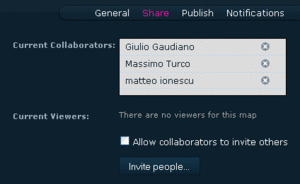 One of the more exciting and useful features of MindMeister and other mindmapping tools is its ability to let you edit and modify a mindmap in real-time together with other people connecting via the Internet. In my personal experience , such visual brainstorming approach turns out to be very effective allowing team-members to participate in an idea or planning process definition, while making it extremely simple to do so.
One of the more exciting and useful features of MindMeister and other mindmapping tools is its ability to let you edit and modify a mindmap in real-time together with other people connecting via the Internet. In my personal experience , such visual brainstorming approach turns out to be very effective allowing team-members to participate in an idea or planning process definition, while making it extremely simple to do so.
Map Interlinking
 Any node on any map can become a central node for a new map. By right-clicking on any node ti is possible to generate a new map, linked to the one you are working on, in which the node you have selected will be the central one and any sub-nodes your selected node has will be carried over in the new map as well.
Any node on any map can become a central node for a new map. By right-clicking on any node ti is possible to generate a new map, linked to the one you are working on, in which the node you have selected will be the central one and any sub-nodes your selected node has will be carried over in the new map as well.
History
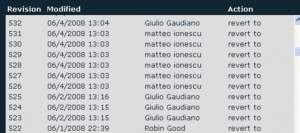 A MindMeister mindmap is just like a wiki. It records all of the changes and edits made to anyone mindmap and allows you to review all such changes and, if needed, to switch back to a previously edited version of your mindmap at any time.
A MindMeister mindmap is just like a wiki. It records all of the changes and edits made to anyone mindmap and allows you to review all such changes and, if needed, to switch back to a previously edited version of your mindmap at any time.
Formatting
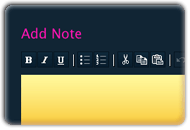 Each and every node on a mindmap can ve easily formatted with larger or smaller text sizes, bold, italic and more. Small icons can also be easily added to each node to more easily characterize the node type or urgency.
Each and every node on a mindmap can ve easily formatted with larger or smaller text sizes, bold, italic and more. Small icons can also be easily added to each node to more easily characterize the node type or urgency.
Task Management
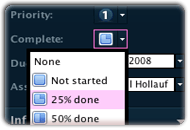 You can add task information to any mindmap node such as priority level, completion, due date and person assigned to execute that task.
You can add task information to any mindmap node such as priority level, completion, due date and person assigned to execute that task.
Attach Images
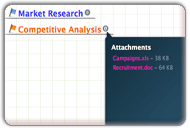 You can upload file attachments to mindmap nodes and preview images through inline thumbnails. While, this feature is only for paying Premium users, everybody can try it out free for the trial period of 30 days.
You can upload file attachments to mindmap nodes and preview images through inline thumbnails. While, this feature is only for paying Premium users, everybody can try it out free for the trial period of 30 days.
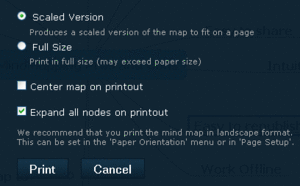 Each and very mindmap created can be easily printed no matter how large and complex it has become .Printing options allow you to center the mindmap on the printout and to fit it to your paper size format automatically.
Each and very mindmap created can be easily printed no matter how large and complex it has become .Printing options allow you to center the mindmap on the printout and to fit it to your paper size format automatically.
Export
 Mindmaps can be easily exported in the two most popular mindmapping formats (FreeMind and MindJet) as well as to stndard PDF files.
Mindmaps can be easily exported in the two most popular mindmapping formats (FreeMind and MindJet) as well as to stndard PDF files.
Import
 Pre-existing mindmaps can also be easily imported. Supported formats include .mm FreeMind and .mmap Mindjet MindManager™ maps.
Pre-existing mindmaps can also be easily imported. Supported formats include .mm FreeMind and .mmap Mindjet MindManager™ maps.
Work offline
Extended Collaboration
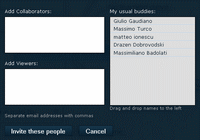 Just like in Google Documents you can allow your team collaborators to invite others when sharing a map - this will also work for already shared maps.
Just like in Google Documents you can allow your team collaborators to invite others when sharing a map - this will also work for already shared maps.
Notes and links
 MindMeister allows you to attach document notes to any mindmap node as well as standard link to any public Internet web page.
MindMeister allows you to attach document notes to any mindmap node as well as standard link to any public Internet web page.
OpenID
 MindMeister fully supports login through the OpenID standard.
MindMeister fully supports login through the OpenID standard.
Web Syndication - Embeddable Widget
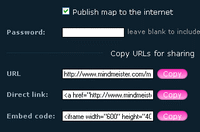 Mindmaps can be easily shared with others privately or publicly published on the Internet both via a public URL on MindMeister as well as via an embeddable iframe piece of code that you can use to embed your mindmap in just about any web page or blog you want.
Mindmaps can be easily shared with others privately or publicly published on the Internet both via a public URL on MindMeister as well as via an embeddable iframe piece of code that you can use to embed your mindmap in just about any web page or blog you want.
Other Cool Features
 MindMeister sports quite a number of other cool features including widgets and extensions that allow you to jot down mindmaps instantly even when you are not on your MindMeister page. Either via the IE8 or the FireFox search box you can start mindmapping instantly. A widget compatible with most start oages is also available as well as the possibility to initiate a mindmap by email or from your mobile phone.
MindMeister sports quite a number of other cool features including widgets and extensions that allow you to jot down mindmaps instantly even when you are not on your MindMeister page. Either via the IE8 or the FireFox search box you can start mindmapping instantly. A widget compatible with most start oages is also available as well as the possibility to initiate a mindmap by email or from your mobile phone.
MindMeister - Summary
Pros - Key Benefits
- Immediate
- Easy to use - intuitive
- No learning curve
- Editable with others in real-time
- Supports basic project management needs
- Exportable to other formats
- Import existing mindmaps from FreeMind and MindJet MindManager
- Printable
- Operate from email or mobile phone
- Free - base version
- Unlimited users and maps when utilizing very affordable paid version
Cons - Areas for Improvement
Let me say first that I am honestly having a hard time finding items to list under this section. MindMeister is such a great tool, that at least for now (and I have created already 20 maps that I use for work), has almost every need I have covered on this front. Yes, there are a few items that would further improve its overall quality, but this is one of those rare tools that is useful and compelling from the first moment you start using it. Here the few that I have found:- Add additional center nodes within one mind-map. Not having the possibility to add another floating item or another center node with one mindmap stumbled me a few times. I don't know whether this is possible but it would certainly be a useful addition for me and my team.
- Provide table or other summary view of task management information provided for a mindmap. It would be nice to be able to consult all task or roles assigned in a chronological or priority-ordered list. And to reflect such views on the map display itself! E.g.: Display items in mindmap sorted by priority order according to clockwise display.
- Create an easy way to go back to the mother map when working in a sub-map created out of a node in another mindmap.
- Improve mindmapping files management facility especially when you start having more than 20 mindmaps. It would be very useful to be able to create folders in which to group and organize your work files.
Editor's Comments
MIndmapping is one of the coolest rediscoveries I have made recently. Nonetheless mindmaps are nothing new in the fields of data visualization and creative brainstorming, thanks to the new possibilities made available by web-based applications and by the opportunity to edit mindmaps in real-time with your team collaborators, mindmap technology is mature enough to become a powerful instrument for communication, idea-generatin, planning, creative brainstorming, training and marketing in just about any market I can think of. The need for thinking and visualizing ideas, connections and relationships is just about everywhere. The easier to use and the cheaper to buy a technology becomes the wider is adoption. Mindmapping is now as easy to use as it can get and the cost to start using them is only your initial time. Tools like MindMeister make it extremely easy to sign-up, join and try out this powerful data visualization technology in no time at all. I have strong doubts that if you leverage all the power available inside MindMeister you need to shell the $300 that Mindjet Mindmanager, the de facto market leader in this sector, commands. Yes, there is NO COMPARISON, in the number of features that MindManager Pro has compared to MindMeister, but... if you are not already a mindmapping pro, I advise you to start with a tool like MindMeister which will make it much easier for you to become literate and familiar with this fantastic way of communicating. If you have not tried mindmapping yet, I strongly recommend you give this technology a good try. (P.S.: Google will need to get something like this in its suite. It is just too useful and too viral not to leverage its truly outstanding potential.)Learn More About MeindMeister
 Pricing and Membership Plans
General Information
MindMeister Tools and Widgets
MindMeister Public Maps
MindMeister Blog
Pricing and Membership Plans
General Information
MindMeister Tools and Widgets
MindMeister Public Maps
MindMeister Blog
 Screencast courtesy of demogirl.com
Screencast courtesy of demogirl.com
Originally written by Robin for Master New Media and first published on June 17th 2008 as "Web-Based Mind-Mapping: Outline, Plan and Brainstorm Ideas Together With MindMeister"
Taxonomy upgrade extras:
Pages
Learn about our legal services for: App Developers, Artists & Graphic Designers, Bloggers & Journalists, Clothing Designers, Entrepreneurs, E-commerce Business People & Startups, Filmmakers & YouTube creators, Public Broadcasting producers,Game Developers, Internet users & Smartphone users, Makers, Musicians, Non-Profits, Photographers, Scholars, Researchers, and Writers and Publishers.





